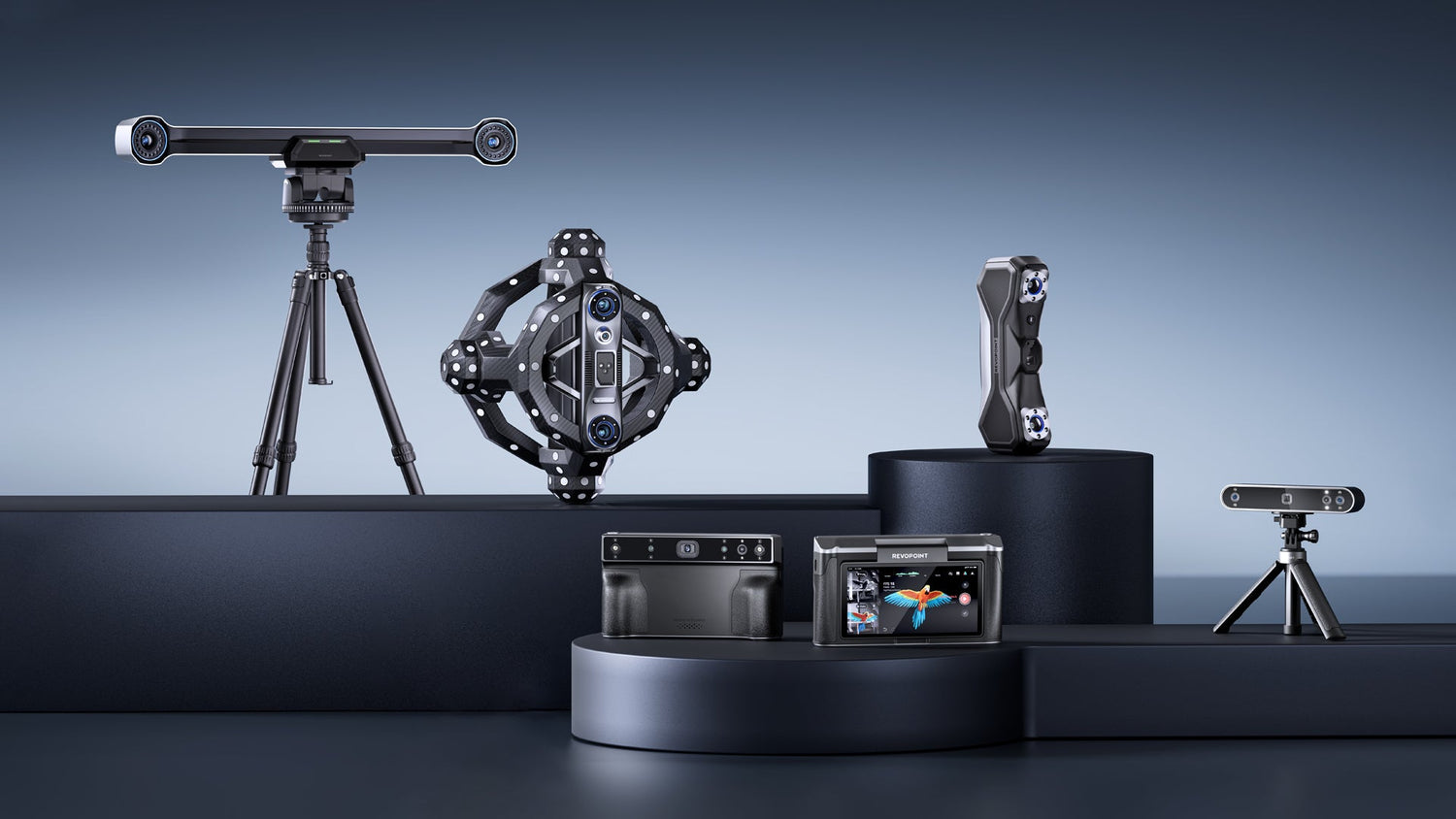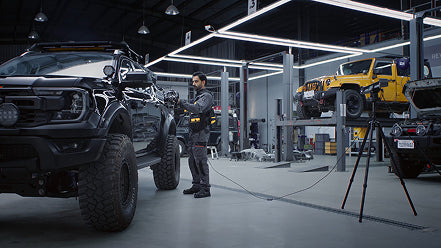Choosing the right 3D scanner can feel overwhelming with the variety of technologies, features, and price points available today. Whether you’re an engineer, designer, educator, or hobbyist, understanding the essential factors is key to finding a 3D scanner that best matches your workflow. In this 3D scanner buying guide, we’ll walk you through the most important considerations—accuracy, resolution, speed, usability, and more—so you can make an informed decision tailored to your unique application.
Understanding 3D Scanning Technologies

Modern 3D scanners are built on several core technologies, each with its strengths. Structured light scanners use projected patterns to capture surface geometry, making them ideal for detailed, textured surfaces. Laser scanners, including blue light and hybrid systems, excel at scanning shiny, dark, or complex industrial objects with high precision. Photogrammetry reconstructs 3D models from photographs and is a cost-effective option for larger or less detailed subjects. When considering which 3D scanning solution is right for you, start by identifying your main use cases—reverse engineering, quality inspection, 3D printing, or digital archiving.
Key Criteria for Choosing a 3D Scanner
Accuracy and Resolution
Accuracy describes how closely the digital scan matches real-world dimensions. For tasks like metrology, engineering, or dental modeling, sub-millimeter accuracy (0.02–0.1mm) is crucial. Resolution, meanwhile, defines the smallest surface detail the scanner can capture. High-resolution scanners are indispensable for intricate objects, such as jewelry or finely detailed prototypes, while larger, less detailed objects like automotive panels may only need moderate resolution.
Speed and Efficiency
The speed of a 3D scanner is typically determined by its frame rate and how many data points it can collect per second. High-speed scanners are invaluable for scanning large items or capturing moving subjects, reducing the time spent on each project. Look for solutions that combine fast acquisition with efficient post-processing tools to streamline your workflow.
Object Size and Range
Scanners are often optimized for specific object sizes—some excel at small components, while others can handle everything from a bolt to a full-sized vehicle. Handheld models like the POP 3 Plus offer flexibility for medium objects, whereas devices like the MIRACO Plus can scan both small and large items, making them versatile across various industries.
Ease of Use and Portability
Usability matters, especially for teams new to 3D scanning. Features such as wireless connectivity, intuitive software, and all-in-one operation (as seen in standalone scanners like MIRACO Plus) lower the barrier to entry and support rapid deployment in the field. Lightweight, portable scanners are ideal for on-site work or educational settings.
Software Integration and File Compatibility
The usability of a 3D scanner’s software is as important as its hardware. Choose scanners with user-friendly software that supports mesh editing and auto-alignment. For instance, Revo Scan, provided with Revopoint scanners, offers intuitive operation that simplifies the scanning process. While additional tools like QuickSurface Pro are helpful for converting scans to CAD-compatible formats, having accessible core software greatly enhances the overall experience.
Budget and Value
3D scanner prices vary widely, from entry-level models to advanced industrial-grade systems. While it’s tempting to focus on cost alone, consider total value—accuracy, reliability, support, and upgradeability. Entry options such as the INSPIRE scanner offer a cost-effective gateway for students and makers, while models like MetroX and Trackit deliver industrial-grade precision for demanding applications.

Application Scenarios: Matching the Scanner to Your Needs
● Reverse Engineering & CAD: For engineering and product design, prioritize accuracy, resolution, and compatibility with CAD software. Devices like Revopoint MetroX and MIRACO Plus, paired with Revo Design, streamline the process from physical object to editable CAD model.
● 3D Printing: Look for scanners that produce watertight meshes in formats ready for slicer software. POP 3 Plus and MIRACO Plus are popular for their balance of speed, accuracy, and user-friendly workflows.
● Education & Prototyping: Portability, affordability, and intuitive software are key. INSPIRE offers accessible entry for classrooms and rapid prototyping projects.
● Industrial Metrology & Inspection: Opt for scanners with metrology-grade accuracy and robust deviation analysis features, such as MetroX or Trackit, to ensure conformity and quality control.
Practical Tips for 3D Scanner Selection
● Evaluate your primary application—precision, object size, and workflow integration matter more than specs alone.
● Consider the environment: portability and battery life are crucial for field work, while stable, mountable systems are suited to controlled lab settings.
● Check for software updates, customer support, and community resources to ensure long-term value.
● When possible, request a demo or trial to assess ease of use and real-world performance.
Why a Complete Ecosystem Matters
A streamlined workflow from scan to CAD or 3D print is essential for productivity. At Revopoint, we are dedicated to developing comprehensive solutions that combine advanced hardware with intelligent software, empowering users at every skill level. Our ecosystem addresses the needs of engineers, educators, and creators alike, ensuring compatibility, reliable support, and continuous innovation.
3D Scanning Workflow: From Capture to Output
A successful 3D scan starts with careful preparation. Begin by cleaning your object and, if it’s reflective or transparent, apply a scanning spray for optimal results. During scanning, maintain a consistent distance and ensure each pass overlaps to prevent missing areas. All Revopoint 3D scanners work seamlessly with their scanning software to provide real-time feedback, allowing you to monitor coverage and make adjustments as needed.

Revo Scan and Revo Design work seamlessly together to enable an efficient workflow from 3D scanning to CAD modeling. Start by using Revo Scan to capture your object’s 3D data, generating point cloud or mesh files with robust tools for mesh editing, including hole filling and surface smoothing. The scan data can then be directly imported into Revo Design with just one click—no manual export or import required. In Revo Design, you can perform advanced operations such as reverse engineering and parametric modeling, quickly converting your scan data into editable CAD models. You can also export your results in standard CAD formats like IGES or STEP, making them ideal for downstream engineering applications. This seamless integration greatly improves modeling efficiency and simplifies your data processing workflow.
Common Pitfalls and How to Avoid Them
Problems like poor alignment, missing details, or rough surfaces are common in 3D scanning. These often result from hasty scanning, incorrect resolution, or unstable environments. Always choose a scanner with the right accuracy for your needs—fine details demand higher resolution. Make sure your workspace is stable and well-lit to improve scan consistency.
Post-processing is just as important as scanning. Learn your scanner’s software to clean up meshes, remove noise, and properly export files. Revopoint tools help streamline these steps with user-friendly workflows, so you can avoid most common mistakes and get reliable results.
Quick Introduction to Revopoint’s 3D Scanner Range

Revopoint offers a diverse portfolio of 3D scanners engineered for accuracy, portability, and ease of use—making them suitable for professionals, educators, and creators alike. Whether your focus is detailed industrial inspection or rapid prototyping, there’s a Revopoint model tailored to your workflow.
● MetroX 3D Scanner: Delivers industrial-grade precision with blue light technology, ideal for reverse engineering and quality inspection—even on shiny or dark surfaces.
● Trackit 3D Scanner: The latest marker-free optical tracking 3D scanner, featuring 30 blue cross-line lasers and a dual-camera base station for high-accuracy scans of objects from 10 mm to 6 meters. Ideal for industrial applications, Trackit delivers efficient, detailed scanning with both optical tracking and handheld modes.
● MIRACO & MIRACO Plus: Standalone, all-in-one solutions for scanning and processing; MIRACO Plus adds measurement functions and both excel at scanning objects of any size without a PC.
● POP 3 Plus: Lightweight, portable, and versatile, with accurate color capture—perfect for product design, education, and creative tasks.
● INSPIRE 3D Scanner: An entry-level option for vibrant, easy scans, especially suited for classrooms, healthcare, and beginners.
Each scanner works seamlessly with Revopoint’s software and accessories, streamlining your workflow from scan capture to CAD modeling or 3D printing—so you can focus on results, not complexity.
Conclusion
Finding the right 3D scanner is about matching the tool to your needs, not just chasing the highest specs. Consider accuracy, resolution, speed, ease of use, and software integration to select a solution that fits your workflow and budget. With a careful approach, you’ll unlock new possibilities in design, manufacturing, and creativity—backed by the confidence of a reliable 3D scanning platform.
For more detailed comparisons, in-depth guides, and personalized advice, explore Revopoint’s range of 3D scanning solutions and discover how the right technology can elevate your projects from concept to reality.



Leave a comment
This site is protected by hCaptcha and the hCaptcha Privacy Policy and Terms of Service apply.